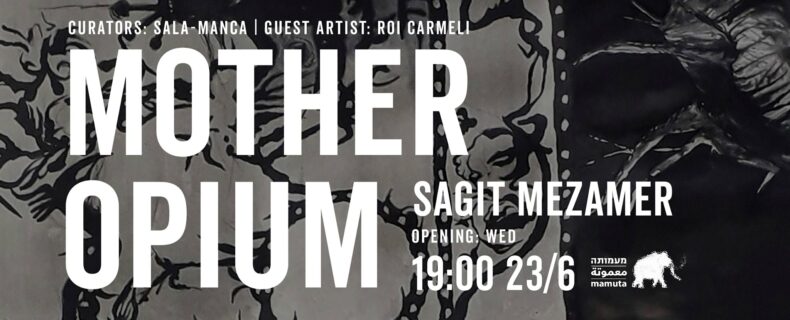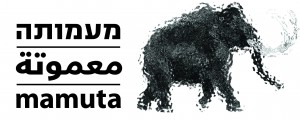(Hebrew) Mother Opium, שגית מזמר, פתיחה: 23.06, 19:00

Mother Opium
Sagit Mezamer
Curation: Sala-Manca
Opening: 23.06, Wednesday, 19:00
The exhibit Mother Opium is the fruit of artist-researcher Sagit Mezamer’s inquiry into the subject of drug addiction, specifically opiate addiction. In her research, Mezamer explored early representations of opium rituals and in parallel documented her conversations over the course of two years with people struggling with opiate addiction.
Evidence of rituals of the Poppy Goddess can be found around Crete and the Mediterranean Basin going back to the Bronze Age, teaching us about the benefits and ways of use of the opium poppy. One of the earliest artifacts of such opium rites is a statuette of the Poppy Goddess, or as she is called in this exhibit — “Mother Opium.” The statuette was discovered in 1937 in northern Crete, in an area inhabited by the Minoans around 1500 BCE. The 78-centimeter-tall statuette is of a standing woman, her hands outstretched, her eyes closed, and her face calm, perhaps even in a state of ecstasy or trance. She wears a crown made of three hairpins in the shape of a poppy fruit. Each fruit head appears to be slit several times — evidence that the latex was used for making opium. Another finding from the same period is of a clay opium pipe, which, by its size, is assumed to have been used for group or tribal rituals conducted by a priest or priestess. Opium played a central role in late Hellenistic culture as well. In Greek mythology the poppy and opium flowers were considered sacred to Demeter, the goddess of fertility, the harvest, and the cycle of life and death. She often appears in images holding a sheath of wheat in one hand and a poppy in the other. Other myths connect the opium poppy to Nyx the goddess of the night, Hypnos the god of sleep, Morpheus the god of dreams, and Thanatos the god of death.
The video work presented in this exhibit is dedicated to a two-year-long conversation between the artist and former DJ Dani Levy, who has struggled with opiate addiction for more than 20 years. Over the past two years Mezamer held a series of encounters with Levy in his home, in which he told about his opiate use and the process of withdrawal he went through with the help of the iboga root, which in the 1960s was discovered in the west as being helpful in weaning off of opiates. The source of the use of the iboga root is in the Bwiti cult in Africa, where it has been used for some 1,500 years in healing rituals, religious ceremonies, and rites of restoration and rehabilitation of individuals who have been cut off from the community as a result of mental or physical distress. In recent years Levy has worked to raise awareness about the treatment of addiction using iboga, which is illegal in Israel. Through her encounters with Levy, Mezamer herself began to investigate the plant and to look at studies written about it in the context of treatment of addiction.
Alongside the video work Mezamer presents a series of scrolls, ink drawings, watercolors on paper, and sculptures created in cooperation with the artist Roi Carmeli. The exhibit reveals rich worlds of drawing and material, as well as ancient sources of visual images. Mezamer moves between past and present, blending these in an act of documentation and interpretation that raises questions about the boundaries we put up in the encounter with the other and about what as a society we have the ability to accept. She weaves together the destructive and the sacred, the deadly and the liberating, and asks to recall a simple yet forgotten belief, that humanity is fundamentally based on the yearning for connection, for belonging. In the words of Johann Hari in his book Chasing the Scream:
“The opposite of addiction is not sobrietyֿ. The opposite of addiction is connection.”
Sagit Mezamer is an artist and psychologist. Her works have been presented at museums and galleries in Israel and abroad, including the Israel Museum, the Herzliya Museum, and Kunsthalle Zürich. Her works can be found in the collections of museums and private collections. Between 2010 and 2013 she was co-curator at Yaffo 23, the nonprofit art space of the Bezalel Academy of Arts and Design. Between 2014 and 2017 she initiated and was artistic director of the residency program “The Curfew Tower” in northern Ireland, for artists and writers from Israel. Since 2018 she has been an artist-researcher in the residency program at the Mamuta Art & Research Center. She is presently training in Gabor Mate’s treatment method known as Compassionate Inquiry, and is promoting his methods and the translation of his writings into Hebrew.
With the support of Miffal Hapays, The Ministry of Culture and the Jerusalem Municipality
Thanks:
Anna Crystal, Mezamer family, Adel Levin, Gideon Lev, Ornit Arnon, Kobi Frige, Nino Biniashvili, Amit mann, Itai Froumin, Itamar Mendes-Flor, Yehudit Shlosberg-Yogev, Itamar Mevorah, Nir Harel, Masha Zusman, Halil Balabin, Shahar Yahlom, Tchelet Ram, Hagit Keysar, Elad Orian, Efrat Appel.
Upcoming Events:
To The Roots
Wednesday 11/8 19:30
A lecture and talk with Sagit Mezmer
Facebook Event
Wednesday 18/8 19:30
Shimon Pinto and Sagit Mezamer in conversation
Facebook Event
Previous Events:
“In the realm of hungry ghosts: close encounters with addiction”
Wednesday 14/07 19:30
Launch of Gabor Maté’s book and a conversation with Prof. Shauli Lev-Ran
Facebook Event


